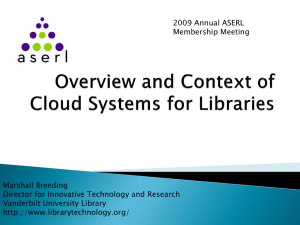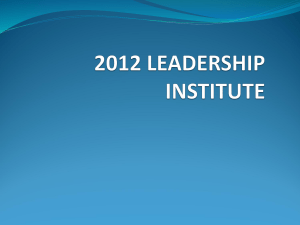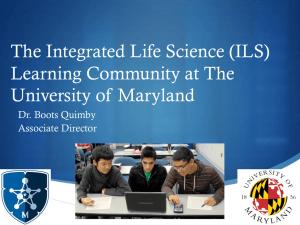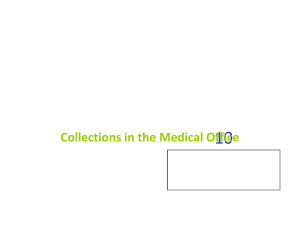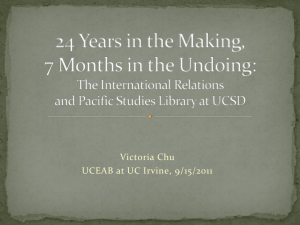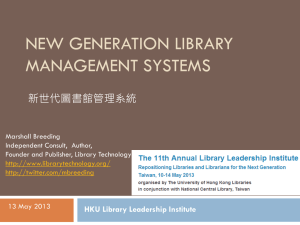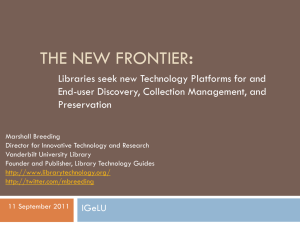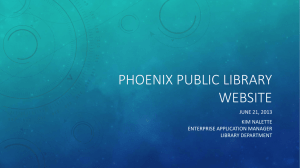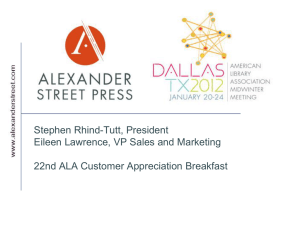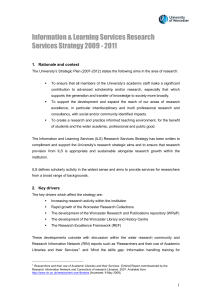Cloud Discovery Services for Libraries
advertisement
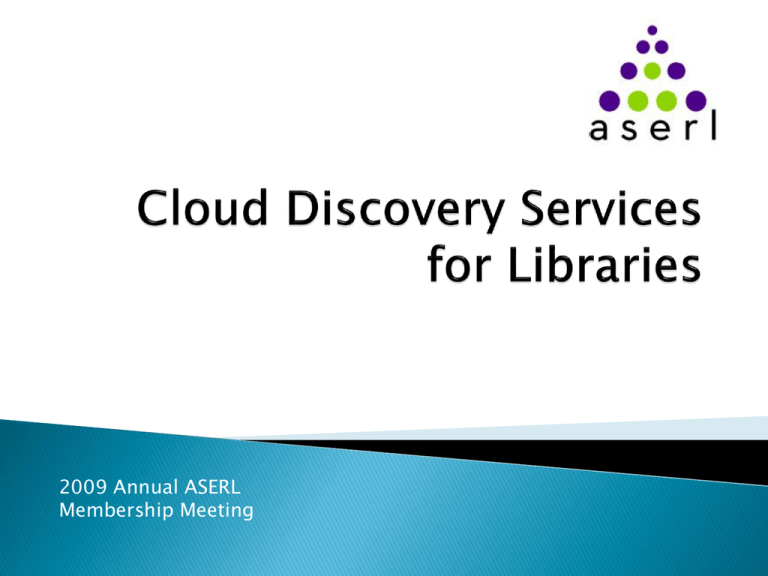
2009 Annual ASERL Membership Meeting 5 mins Welcome & Introductions -- John Burger 20 mins Overview & Context of ‘Cloud’ Systems for Libraries Marshall Breeding 20 mins Insights from User Study Data that led to development/functionalities of Summon – John Law 20 mins Reasons for Implementing Summon at GVSU, Reactions from Users, Other Lessons Learned along the way – Ron Berry 20 mins Reasons for Implementing WorldCat Local at USF, Reactions from Users, Other Lessons Learned along the way – Bill Garrison 20 mins Q & A from ASERL members – Marshall Breeding, moderator 2009 Annual ASERL Membership Meeting Marshall Breeding Director for Innovative Technology and Research Vanderbilt University Library http://www.librarytechnology.org/ Highly abstracted model of computing Displaces the need for local hardware and software Provisioned on demand Metered use of storage and computing cycles Platform-as-a-service Storage-as-a-service Emerging model for library discovery and automation Increasingly dubbed “Web-scale” Lots of non-library Web destinations deliver content to library patrons ◦ ◦ ◦ ◦ Google Scholar Amazon.com Wikipedia Ask.com Do Library Web sites and catalogs meet the information needs of our users? Do they attract their interest? Print > Electronic Increasing emphasis on subscribed content, especially articles and databases Strong emphasis on digitizing local collections New generations of library users: ◦ Millennial generation ◦ Web savvy ◦ Pervasive Web 2.0 concepts Silos Prevail ◦ Books: Library OPAC (ILS module) ◦ Articles: Aggregated content products, ejournal collections ◦ OpenURL linking services ◦ E-journal finding aids (Often managed by link resolver) ◦ Local digital collections ETDs, photos, rich media collections ◦ Metasearch engines All searched separately More comprehensive information discovery environments Primary search tool that extends beyond print resources Digital resources cannot be an afterthought Systems designed for e-content only are also problematic Forcing users to use different interfaces depending on type of content becoming less tenable Libraries working toward consolidated user environments that give equal footing to digital and print resources Bound handwritten catalogs Card Catalogs Library online catalogs – OPACs Discovery interfaces Web-scale discovery services A single point of entry to all the content and services offered by the library Search: Single search box Query tools ◦ Did you mean ◦ Type-ahead Relevance ranked results Faceted navigation Enhanced visual displays ◦ Cover art ◦ Summaries, reviews, Recommendation services Online Catalog ◦ Interface conventions from an earlier Web era ◦ Scope: Tied to the ILS and its content domain Discovery Layer ◦ Modern interface elements ◦ Scope: aims to address broad range of components that constitute library collections AquaBrowser Ex Libris Primo Innovative Interfaces: Encore Serials Solutions: Summon (under development) SirsiDynix Enterprise The Library Corporation: LS2 PAC VUFind (open source) BiblioCommons eXtensible Catalog (under development) ◦ Tags, user-supplied ratings and reviews ◦ Leverage social networking interactions to assist readers in identifying interesting materials: BiblioCommons ◦ Leverage use data for a recommendation service of scholarly content based on link resolver data: Ex Libris bX service Initial products focused on technology ◦ AquaBrowser, Endeca, Primo, Encore, VUfind ◦ Mostly locally-installed software Current phase focused on pre-populated indexes that aim to deliver Web-scale discovery ◦ ◦ ◦ ◦ Summon (Serials Solutions) WorldCat Local (OCLC) EBSCO Discovery Service (EBSCO) Primo Central Federated Search / Metasearch use real-time queries against multiple information targets No centralized index – presentation of dynamic results Shallow results -- only a few results initially fetched from each target Difficult to calculate relevancy Performance challenges ILS Data Digital Collections Search: ProQuest Search Results EBSCOhost … MLA Bibliography ABC-CLIO Real-time query and responses ILS Data Search: Local Index Digital Collections ProQuest Search Results MetaSearch Engine EBSCOhost … MLA Bibliography ABC-CLIO Real-time query and responses ILS Data Search Results Consolidated Index Search: Digital Collections ProQuest EBSCOhost … MLA Bibliography ABC-CLIO Pre-built harvesting and indexing Pre-populated indexes Web-scale ◦ Exploits the full depth and breadth of library collections ◦ Beyond the bounds of the local library’s collection ◦ Targets the universe of objective, vetted library content Includes full-text indexing to the fullest extent possible Indexing the full corpus of information available globally Or at least major portions Not quite comprehensive – partial harvesting of any given resource Google aims to address all the world’s information Discovery Layer Products for libraries aim to address all content collected by libraries: Print Remotely access electronic content: e-journals, e-books, databases, licensed and open access. Local special collections: digital and print. Addresses the comprehensive body of content held within library collections Comprehensive, unified New-generation interface Harvested local content ◦ ILS metadata ◦ Institutional repositories, ETDs, Digital Collection platforms Vendor-supplied indexes of library content ◦ E-journals, databases, e-books Full-text and metadata corresponding to e-content subscriptions ◦ Book collections beyond local library collections Entering post-metadata search era Increasing opportunities to search the full contents ◦ Google Library Print, Google Publisher, Open Content Alliance, government publications, etc. ◦ High-quality metadata will improve search precision Commercial search providers already offer “search inside the book” and searching across the full text of large book collections Not currently available through most library search environments ◦ Will be an important feature of projects such as HathiTrust Deep search highly improved by high-quality metadata Now viewed as separate problem Many interdependencies Current model of feeding discovery systems from many underlying repositories ◦ ILS / e-journal collections / collections of digital objects Will models of resource management change to consolidate the repositories? Realign Discovery and management? Traditional Proprietary Commercial ILS ◦ Millennium, Symphony, Polaris Traditional Open Source ILS ◦ Evergreen, Koha Clean slate automation framework (SOA, enterprise-ready) ◦ Ex Libris URM, OLE Project Cloud-based automation system ◦ WorldCat Local (+circ, acq, license management) Beyond selecting one brand from an assortment of similar products Several conceptually diverse options Companies and projects now competing on innovation
